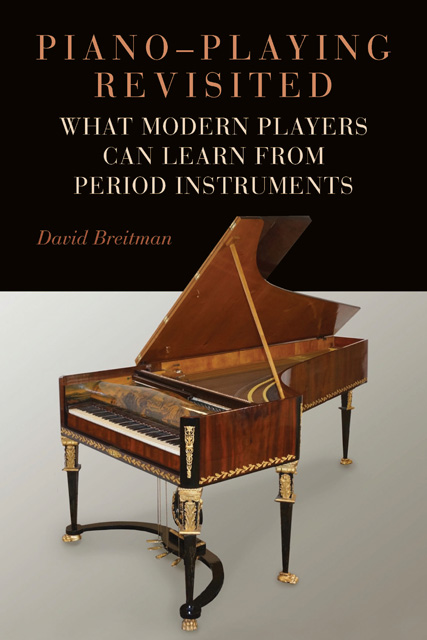Book contents
- Frontmatter
- Dedication
- Contents
- List of Illustrations
- Preface
- Acknowledgments
- 1 Music Making Then and Now
- 2 With Broad Strokes (An Overview)
- 3 The Early Days of the Piano: Haydn and Mozart
- 4 Beethoven and the Evolving Piano
- 5 Schubert
- 6 Chopin
- 7 The Clavichord
- Epilogue: Creativity in the Performance of Old Music
- Appendix: Overtone Structure of the Steinway and Walter, Compared
- Glossary of Terms
- Notes
- Bibliography
- Index of Works
- General Index
- Frontmatter
- Dedication
- Contents
- List of Illustrations
- Preface
- Acknowledgments
- 1 Music Making Then and Now
- 2 With Broad Strokes (An Overview)
- 3 The Early Days of the Piano: Haydn and Mozart
- 4 Beethoven and the Evolving Piano
- 5 Schubert
- 6 Chopin
- 7 The Clavichord
- Epilogue: Creativity in the Performance of Old Music
- Appendix: Overtone Structure of the Steinway and Walter, Compared
- Glossary of Terms
- Notes
- Bibliography
- Index of Works
- General Index
Summary
Last but Not Least …
This is a book about pianos and piano-playing, so I didn’t feature the clavichord at the beginning—even if that’s where it belongs chronologically. But because of its crucial role in my own thinking and because it made such a big impression on the students in the seminar, I couldn’t leave it out, either.
Today the clavichord seems exotic, but in eighteenth-century Germany it was the most common of all keyboard instruments, known by the generic term Clavier (“keyboard”). It was also the least expensive, since the case is just a rectangular box and the only moving parts are the keys themselves. Figure 7.1 shows how it works, and the website https://vimeo.com/showcase/8046349 includes several clips relating to the clavichord. There are no dampers for the strings. Instead, a long strip of cloth (“listing”) prevents them from vibrating until a key is depressed, when the tangent (a piece of brass attached to the end of the key opposite the player’s finger) divides the corresponding strings (usually two per unison) into two segments. Then the sounding length (the segment from the tangent to the bridge), energized by the tangent, is free to vibrate until the key is released, when the cloth again damps the entire string.
Despite the elegance and simplicity of its design, the clavichord can be frustratingly difficult to play, since every irregularity in touch is immediately audible (I call it a lie detector). Two approaches to the key that make similar sounds on a piano may produce totally different effects on the clavichord, one beautiful and the next unacceptable. It is also impractical for concerts, since its loudest sound scarcely compares with a modern instrument’s mezzo piano, although its ability to play extremely softly still gives it a wide dynamic range. But along with these liabilities come certain advantages: modulating the pressure on a key affects the sustain of a note, or its pitch, and can even create a vibrato (Bebung). C. P. E. Bach’s remark that a good clavichordist makes an accomplished harpsichordist, but not the reverse, becomes easy to understand after a few minutes’ acquaintance with the instrument.
- Type
- Chapter
- Information
- Piano-Playing RevisitedWhat Modern Players Can Learn from Period Instruments, pp. 158 - 168Publisher: Boydell & BrewerPrint publication year: 2021



